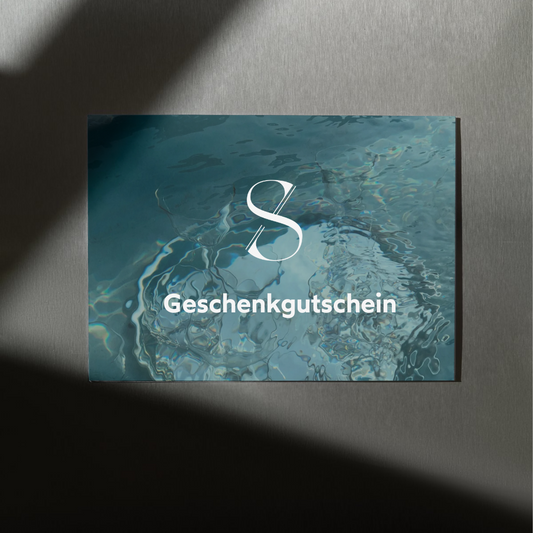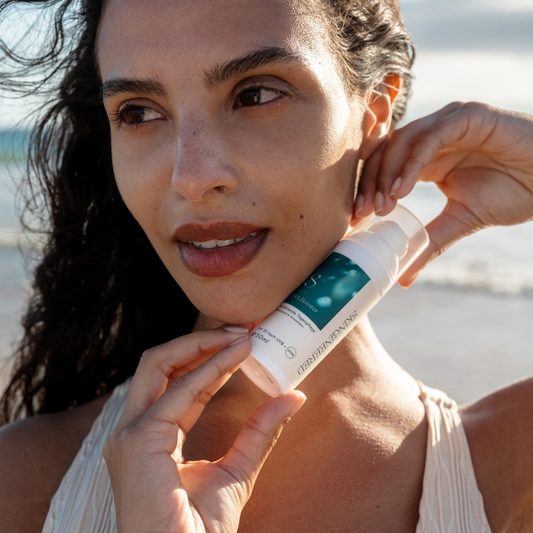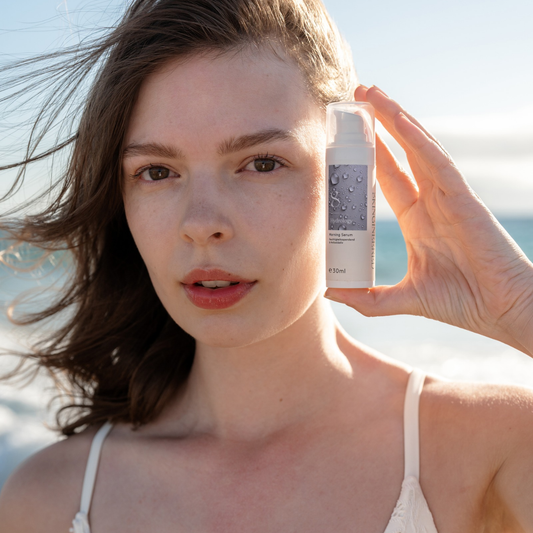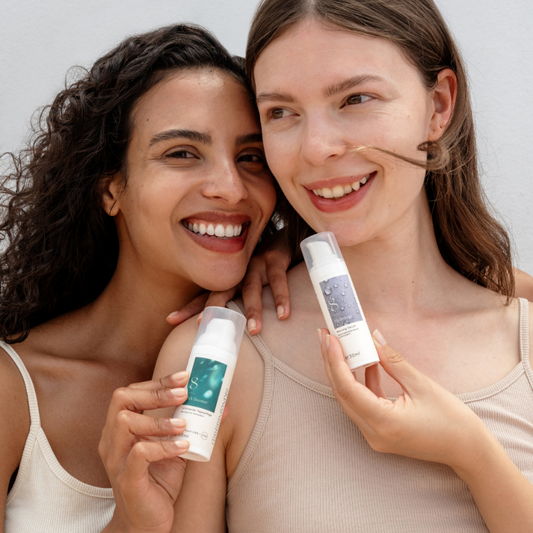UV radiation is one of the most significant external factors influencing skin aging and skin health. However, not all UV rays are the same. Distinguishing between UVA and UVB rays is essential when it comes to proper sun protection and preventing light-induced skin damage. In this article, you will learn:
Contents:
- What are UV rays ?
- UVB – The sunburn rays
-
UVA – The neglected danger
- Why UVA protection is often lacking
- Is there a self-protection time for UVA rays?
- When should you pay particular attention to UVA protection?
- Approved UV filters with high UVA protection
- Conclusion and product recommendation
What are UV rays?
🌞 UV rays are adjacent to visible light . They have a shorter wavelength and are therefore more energetic than blue/violet light. Hence the name " ultraviolet " (UV). Ultraviolet rays are high-energy light waves, invisible to the human eye, emitted by the sun.

UV rays are further divided into three categories. 1️⃣ UVA rays, although the least energetic, make up 90% of the UV rays that reach us on the Earth's surface. 2️⃣ Only a small portion of UVB rays penetrate the ozone layer. 3️⃣ Fortunately, UVC rays are completely absorbed by the atmosphere.
Therefore, two types are relevant for skincare:
- UVB (280–320 nm)
- UVA (320–400 nm)
Both have different effects – both in the short and long term.
UVB – The sunburn rays
UVB rays have a shorter wavelength and penetrate the outermost layer of skin (epidermis). They are primarily responsible for:
- Sunburn (erythema)
- DNA damage in keratinocytes
- Acute skin inflammations
- Higher risk of skin cancer
The sun protection factor (SPF) of a product primarily indicates how well it protects against UVB radiation. An SPF 30, for example, filters approximately 97% of UVB rays.
--> See also blog article " How long can I stay in the sun? "
UVA – The neglected danger
UVA rays have a longer wavelength and penetrate deeper into the skin, reaching the dermis . There they cause:
- Oxidative stress caused by free radicals
- Degradation of collagen and elastin (photo-aging)
- Disorder of melanin regulation (hyperpigmentation)
- Long-term cell damage and skin cancer risk
While UV B rays mainly cause sunburn and skin cancer , UV A rays penetrate deeper into the skin and are primarily noticeable through premature skin aging and hyperpigmentation .

UVB rays are more energetic and dangerous. However, UVA rays are also responsible for approximately 15% of sunburns (especially in skin type I), and the cumulative effect of long-term exposure also contributes to the risk of skin cancer [1,2]. UVA rays also generate free radicals and inhibit immune cells [3].
While UVB rays are hardly present in our latitudes during winter , UVA intensity fluctuates. less dependent on season, time of day, geography and altitude [4]. UVA rays are only very slightly weighted in the UV index, so that it is mainly an indicator of UVB strength.
Constant light exposure is the main cause of cumulative skin aging .
--> See also blog article " Why sun protection in winter too? "
Why UVA protection is often lacking
🔍 The determination of the UVA protection factor is not as internationally standardized as the SPF (sun protection factor), which primarily indicates protection against UVB radiation . While SPF is clearly communicated in most products, UVA protection is often not specified or is minimal .
🇪🇺 In the EU, ISO 24443 is the primary standard used for UVA protection. A measuring device is used to compare the absorption between the UVA and UVB ranges. If the absorption in the UVA range is at least one-third, the test is considered passed.
🇯🇵 More common in Japan is an in vivo test according to ISO 24442. Here, the reduced skin tanning is compared between unprotected and protected skin on real test subjects (PPD: Persistent Pigment Darkening).
There are also different standards for specifying UVA protection:

The EU minimum standard requires only one-third of the SPF as UVA protection (e.g., SPF 30 = UVA-PF ≥10). This is sufficient for sunburn protection, but not for optimal slow-aging routines .
UVA-PF (UVA Protection Factor) , PA rating (e.g. PA++++) or the UVA label in a circle can provide clues – but only brands that explicitly state the UVA-PF offer true transparency.
Is there a natural protection time for UVA rays? (Similar to the natural UVB protection against sunburn)
While the natural protection time against UVB rays is approximately 5-20 minutes for most European skin types , determining a similar value for UVA rays is difficult. The sun's spectrum always contains both UVA and UVB rays, and sunburn occurs before UVA rays have even produced a tan .
The most significant harmful effect of UVA radiation in the cosmetics sector is photoaging . However, it only occurs after years of chronic UVA exposure and cannot be determined for ethical and practical reasons.
It might be more suitable to measure the formation of free radicals [5]. However, these are not exclusively triggered by UVA rays.

When should you pay particular attention to UVA protection?
- In cases of a tendency towards hyperpigmentation
- For example, in the case of photoallergies such as Mallorca acne.
- To prevent acne scars, e.g., in cases of acne.
- During pregnancy (increased Sensitivity to pigmentation)
Or if you simply want to use the most effective skincare product to prevent unnecessary skin aging. Happy aging is possible without avoidable signs of deterioration. It's not just about appearance, but also about a healthy skin barrier.
Approved UV filters with high UVA protection:
One or more of the following ingredients should be found in your sunscreen:
- Butyl Methoxydibenzoylmethane (Avobenzone, BMDBM)
- Diethylamino Hydroxybenzoyl Hexyl Benzoate (Uvinul® A Plus, DHHB)
- Disodium Phenyl Dibenzimidazole Tetrasulfonate (Neo Heliopan® AP, DPDT)
- Methoxypropylamino Cyclohexenylidene Ethoxyethylcyanoacetate (Mexoryl® 400)
As well as broadband filters:
- Bis-Ethylhexyloxyphenol Methoxyphenyl Triazine (Tinosorb® S, BEMT)
- Methylene bis-benzotriazolyl tetramethylbutylphenol (Tinosorb® M, MBBT)
--> See also blog article " The best UV filters "
Conclusion: Both UVA and UVB rays need protection.
For effective protection:
✅ Pay attention not only to a high SPF (at least 30), but also to designated UVA protection.
✅ Use broadband filter combinations
✅ Apply sunscreen daily and generously
Those who want to take preventative measures against collagen breakdown, pigment spots and loss of elasticity should pay particular attention to the UVA component.
Recommendation:
The Skinengineered UVA Booster offers UVA protection that even exceeds UVB protection – a first on the market. For us, this is an important step towards skin-needs-oriented innovation.
Your Ying
Engineer, cosmetic scientist and founder of Skingineered

Sources:
[1] Khan et al., Roles of UVA Radiation and DNA Damage Responses in Melanoma Pathogenesis, Environmental and Molecular Mutagenesis, 2018
[2] Narayanan DL, Saladi RN, Fox JL. Ultraviolet radiation and skin cancer. Int J Dermatol. 2010
[3] D'Orazio J, Jarrett S, Amaro-Ortiz A, Scott T. UV radiation and the skin. Int J Mol Sci. 2013
[4] Diffey BL. Sources and measurements of ultraviolet radiation. Methods. 2002
[5] Zastrow et al., Free Radical Threshold Value: A New Universal Body Constant, Skin Pharmacol Physiol, 2015











